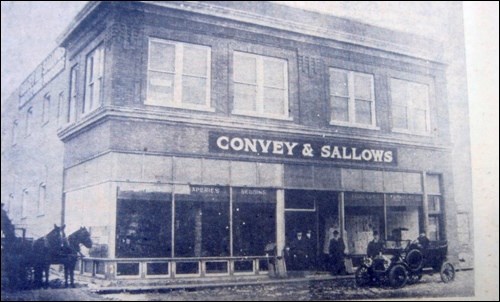At 10103 - 11th Ave. in downtown North Battleford, the once imposing hundred year old Sallows & Boyd building, more recently, and infamously, known as the Pigeon Hotel, stands empty, forlorn and deteriorating. But when the Sallows & Boyd was constructed in 1913, it was an impressive commercial structure and lays claim to an extraordinary and complex history. Over the last century, this historic building housed a funeral parlour, furniture store, doctor's office, CJNB Radio, dentist's office, bargain store and restaurants, to name only a few.
Beginning of a Legacy.
The Sallows & Boyd and an adjoining building on the east side share a common, load-bearing wall which separates the two. The two structures have been mistaken for a single building even though it is readily apparent the brick and masonry work is more ornate and detailed on the west side, and that the east and west exterior walls differ in appearance. The east structure was built in stages sometime after the original Sallows & Boyd building. I have an undated photograph showing a one-storey adjoining structure. Later photographs indicate a second storey was added. In 1914, the original structure was christened the Convey & Sallows building given that the first owners and proprietors were W. H. Convey and Frank Sallows.
Mr. Convey had already set up a funeral business in 1908. He was joined by Frank Sallows as a full partner in 1911. Both gentlemen also had an interest and background in furniture. Convey assumed control of a furniture business that had been operated by Foley and Lienweber from 1905 to 1908. He was joined by Frank Sallows in 1908 who later joined Convey in the funeral business. Sometime later, as explained by Maurice Shaw, Johnny (John) Boyd bought into the business and also worked as a funeral director. John was a brother to George Boyd, an extraordinarily successful man with lucrative interests in real estate and business.
In 1913, North Battleford experienced an unprecedented boom in building construction, new business and city growth. In addition to Convey's and Sallow's new building, the Auditorium Hotel, Third Avenue United Church, the North Battleford Collegiate Institute, the Saskatchewan Hospital, a large number of commercial buildings and many expensive homes on both the west and east sides of the city were either completed or under construction. Most of these buildings, including Convey's and Sallow's, were constructed of brick fired at the North Battleford Brick and Concrete Company organized the previous year. 1913 was also the year North Battleford became a city. It was against this backdrop of optimism and confidence Convey and Sallows set up their furniture and funeral businesses in a new, modern building.
Furniture and Funerals
Using information from documents and the McDonald files, donated by brothers David, Robert and Bruce, made available at the City of North Battleford Historic Archives, I was able to determine the layout of the furniture and funeral businesses at the Sallows & Boyd, and the evolving working relationships over the years. Most of the main floor was a show room for high quality hardwood furniture. The majority of the basement was reserved for bedroom suites, mattresses and box springs, and bedroom accessories (a sump pump operated continuously in the basement because of an underground stream). At the back of the furniture store on the main floor was situated a small chapel and viewing area where mourners could pay their respects to the deceased. Coffins were stored in the basement at the north end adjacent to the display of bedroom furniture. The Sallows & Boyd was heated by steam that was generated by the North Battleford Power House, which began supplying electricity and steam in 1910, piped in from underground lines buried in the ally.
It was common during the first decades of the last century for furniture stores and funeral homes to work together. Master craftsmen who made beautiful hardwood furniture also made ornate hardwood coffins.
In the early years, bodies were not embalmed. This changed when Robert Fordyce McDonald joined the firm in 1927 as manager and vice-president. Mr. McDonald, who came to North Battleford from Weyburn, was a licensed embalmer. He also managed Sallow's and Boyd's furniture business.
The funeral home employed a horse-drawn hearse and carriages for nearly two decades before purchasing a gasoline-powered unit. The horses were kept in a stable which was located near the present day Koopman's Auto Body shop and the Friendship Centre. Horses were broke near the present day Boys and Girls Club. On one occasion, young David McDonald, Robert's son, suffered a significant injury at the breaking corral when he got too close to the action.
In advance of the funeral procession, the horse-drawn hearse would be positioned at the northwest side of the Sallows & Boyd building. Funeral carriages, for immediate family, and close relatives would line up in the alley along the building. The casket would then be carried through a narrow door, still in place and easily seen, on the northwest side of the building and placed in the hearse. The hearse and funeral carriages would then proceed to one of the city churches for the funeral, and later to the cemetery east of the city.
Sallows and Boyd purchased a 1929 Buick hearse in 1932. The hearse was stored in a structure built on to the back of the main building. Maurice Shaw remembered doing maintenance work on this vehicle. Mechanized funeral coaches represented a significant departure from the romantic era of horse drawn carriages but also brought a measure of efficiency to the funeral business.
Despite that horse drawn funeral hearses and carriages were used until the 1930s, Convey and Sallows had purchased a Cadillac ambulance in 1913 even before their new building had opened for business. These enterprising businessmen operated a thriving adjunct emergency medical service (EMS) which their successors continued for many years.
To be continued ...




